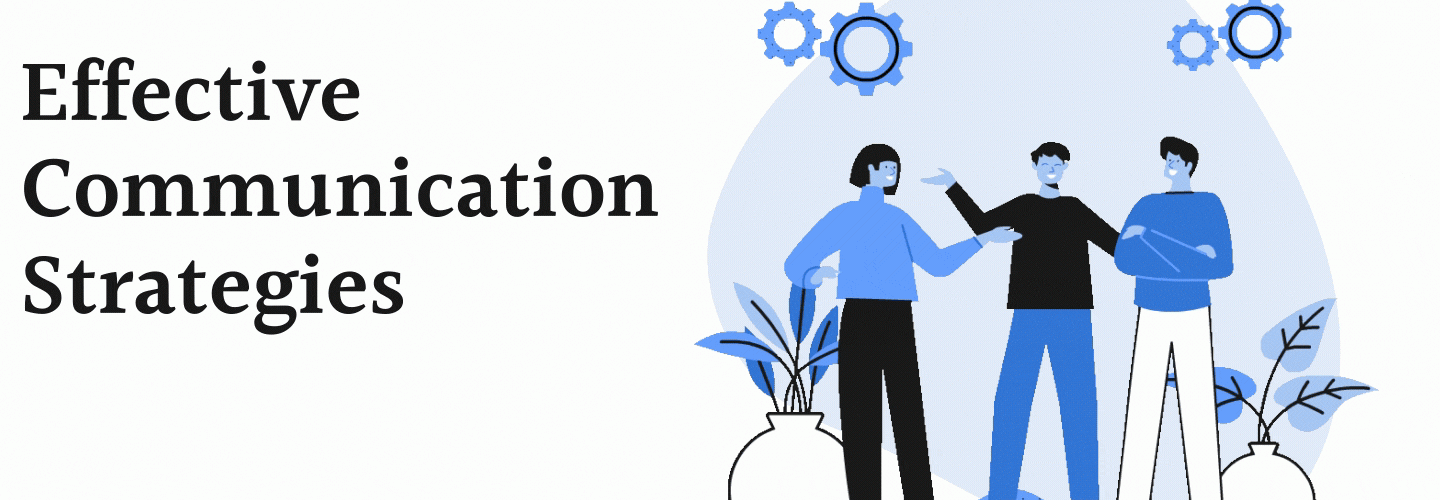BUSINESS
10 Effective Communication Strategies For Remote Teams
Published
5 months agoon
By
wpadminee
In the era of remote work, distributed teams struggle with effective communication. Organizations must implement formal communication strategies for remote teams to create solid team alignment.
While some companies have adopted hybrid work models, a mere 3% of employees and entrepreneurs express readiness to return full-time to physical offices. This means approximately 97% of employed individuals plan to continue working remotely, relying solely on chat, emails, and video meeting tools to connect with colleagues.
Given these circumstances, managers must establish appropriate communication strategies for remote teams and keep employees engaged with their work. This article will explore 10 effective communication strategies to better connect with your remote team.
These strategies aim to bridge the gap created by physical distance and foster a cohesive work environment. By implementing these communication strategies for remote teams, leaders can enhance collaboration, boost productivity, and maintain a strong team culture despite the challenges of distributed work.
The Importance of Communication Strategies for Teams
A friendly and easy-going environment drives employees to choose a workplace, ranking as one of the top non-monetary factors. Nearly half of the younger generation seeks mentoring relationships with managers, and 80% prefer instant feedback over formal performance appraisals.
Consequently, good soft skills give candidates a significant advantage during the hiring process, often tipping the balance in their favour.
A flawless communication strategy results in:
- Achievable goals: Employees understand the manager’s expectations, and managers comprehend each employee’s strengths and qualifications, making the workflow more predictable for both sides.
- Higher confidence: Teams with defined inner roles and well-established processes avoid ambiguity and plan future projects better than disorganized teams.
- Reduced employee turnover: Employees become more acquainted with one another, feeling more relaxed to ask questions, discuss problems, and propose solutions. Consequently, destructive conflicts in the team decrease and fewer people want to leave.
- Higher job satisfaction: Teams that celebrate achievements last longer. Employees value opportunities for public recognition and praise.
Miscommunication in the workplace leads to sad consequences for businesses. It lessens motivation and makes employees dream of cushy jobs. This results in worsening productivity and systematic failures to meet project deadlines.
The following occasional phrases from employees may indicate problems with the communication strategy within the company:
- “I don’t feel my work brings an impact”.
- “I do not grow professionally”.
- “Dialogues with my manager frustrate me”.
- “Our team constantly underachieves KPIs”.
If a company doesn’t react to warning signs of poor communication, it will lose experienced employees and, ultimately, clients.

What is a communication strategy?
Different objectives require specific communication strategies for teams. For instance, a brainstorming session typically involves a larger group, while problem-solving meetings can be more efficient with a focused team of four or five participants.
Smaller teams can easily agree on changes to the Backlog verbally, while cross-functional teams may need a formal meeting, complete with an agenda and summary.
Effective communication strategies for teams involve understanding the context and tailoring the approach accordingly. To build these strategies, managers must grasp employees’ personalities, distinguish communication goals, and set clear objectives.
Understand Team Roles for Successful Communication Strategies for Teams
Effective communication strategies for teams require a clear understanding of team roles. Every team consists of three main types of roles that contribute to overall performance in their own ways:
1. Action-oriented roles: These team members take responsibility head-on, thrive under pressure, and respond to sudden challenges. Action-oriented roles are essential in fast-paced communication strategies for teams.
2. People-oriented roles: Natural leaders who excel at aligning efforts and executing goals. They play a pivotal role in ensuring that team communication strategies run smoothly by facilitating collaboration.
3. Thought-oriented roles: These are employees who think creatively and are confident in presenting new ideas. Their innovative thinking is crucial in shaping forward-looking communication strategies for teams.
Make Employees Aware of Business Goals
Employees need to know how their work aligns with larger business objectives. To create effective communication strategies for teams, managers should clearly outline the company’s long-term mission and objectives.
Avoid generic KPIs and instead explain how performance indicators contribute to the bigger picture. When employees understand how their efforts fit into broader goals, communication strategies for teams become more cohesive and focused.
Encourage Team Input on Communication Strategies
Employees are a company’s greatest asset. Encouraging them to contribute ideas fosters a more engaged and motivated workforce. Major companies like Facebook and Google invest in their employees by promoting open communication and leadership that welcomes innovation.
To develop successful communication strategies for teams, managers should create an environment where team members feel comfortable sharing their ideas. This openness is key to refining communication strategies for teams.
Set Clear KPIs to Track Communication Strategies for Teams
In remote or hybrid work environments, being specific and consistent is critical for effective communication strategies for teams. Managers should clearly outline expected outcomes and deadlines, avoiding ambiguous instructions.
When communication strategies for teams are grounded in measurable KPIs, performance tracking becomes more efficient. For example:
Instead of saying, “You need to improve client calls,” say, “The average duration of your client calls was 5 minutes. Please aim for at least 10 minutes next month to meet your half-year KPI.”
Motivate and Appreciate Team Efforts
Recognizing and rewarding employees is vital in sustaining effective communication strategies for teams. Whether through rewards, extra time off, or verbal recognition, showing appreciation builds trust and strengthens the team’s connection to company goals.
Communication strategies for teams are integral to achieving success. Understanding roles, fostering input, setting clear goals, and recognizing achievements, can help managers create a communication framework that empowers teams to thrive.
What are the 10 strategies to improve communication within teams?
1. Use Collaboration Software
Employees rely on apps in their daily lives, so it’s no surprise they benefit from them at work. Nearly two-thirds of employees report that technology enhances collaboration and boosts productivity. As a result, the team collaboration software market continues to grow by 13.2% annually.
The following digital tools can improve your team’s performance:
i.) Project Management Software
Tools like Nifty help plan, assign and track tasks while managing resources. These apps turn communication into action by integrating tasks, documents, goals, and issue tracking. Team members can easily view updates and align their work with the rest of the team.
ii.) Chats, Video Conferencing Software, and Voice over Internet Protocol (VoIP)
Emails are useful but not sufficient for continuous communication. Affordable tools like Zoom or Cisco Jabber allow teams to chat and share information, just as they would in offline meetings.
For enhanced security, organizations can opt for cloud-based VoIP services or custom communication apps like Amazon Chime.
iii.) Cloud-Based File-Sharing Services
Instead of relying on hard drives, teams benefit more from cloud storage, enabling document access from any device or location. Cloud services also provide file-syncing options, ensuring that all team members are working on the latest versions.
iv.) Multi-Purpose Digital Whiteboards
Digital whiteboards replace physical workspaces by providing an online canvas for notes, Scrumban, or project-related documentation. With templates, built-in messaging, and video-conferencing tools, these whiteboards enhance team collaboration.

2. Speak with a Purpose
While informal chats can be effective, it’s best to provide relevant details before diving into a discussion or presentation. Avoid vague terminology and uncommon acronyms.
Effective communication requires you to focus on the purpose of your message, your audience’s expectations, and any sensitive issues involved.
Make your communication a two-way dialogue. Ask questions to ensure listeners have understood the message correctly. Stay focused and resist reacting to interruptions or disagreements immediately. If conflicting opinions arise, pause, think carefully, and address them later.
3. Avoid Unnecessary Calls and Meetings
If a meeting isn’t necessary, avoid scheduling it. Instead, use direct communication methods like Slack messages or quick calls. Meetings should only be held when introducing new employees, discussing opportunities or threats, or resolving team inconsistencies.
When meetings are necessary, schedule them in advance, provide an agenda, attach relevant documents, and allow time for questions. Afterwards, ensure clear next steps are agreed upon.
4. Know What Communication Channel to Use
Choose your communication channels wisely based on the message, its confidentiality, and the response you expect. Written communication is often best for formal matters, as it allows for backups and records of agreements. Informal discussions, such as calls, are better suited for quick, immediate exchanges.
For businesses, leveraging tools like text message marketing can be a powerful way to reach customers, as long as the messages remain clear and concise.
5. Establish One-to-One Meetings
One-to-one meetings are crucial for syncing with employees, discussing performance, and addressing concerns. Set aside time weekly or monthly for these meetings, and prepare key discussion points in advance.
Remember that these sessions should involve both parties, encouraging open dialogue and reflection.
6. Assign Responsibilities to Improve Communication
Micromanagement can hinder productivity and weaken team morale. To foster strong communication, delegate tasks effectively by outlining expected outcomes and giving employees the authority to achieve them. Clear inputs, deadlines, and guidance help establish trust while maintaining accountability.
7. Address Difficult Conversations Head-On
Avoiding tough conversations only leads to unresolved issues and growing tension. Approach difficult discussions as opportunities for constructive dialogue, where both sides aim to resolve the problem. Allow time for your counterpart to express their thoughts, and avoid dismissing new ideas prematurely.
8. Provide Feedback on Communication Strategies
Feedback helps both parties grow. For managers, it’s a chance to highlight strengths and areas for improvement. Start with positive comments before offering constructive criticism. This approach encourages professional growth and fosters a sense of belonging.
9. Conduct Team-Building Activities
Team-building activities create informal settings that break down barriers and foster better communication. Whether it’s a pizza party or a weekend retreat, these events build trust and encourage collaboration, especially for teams with remote employees.
10. Set Up Communication Strategy Workshops
Communication skills can be improved through formal workshops led by neutral moderators. These workshops involve interactive tasks and group activities that teach participants how to handle conflict and resolve issues effectively.
Implementing these 10 strategies will enhance communication within your team or help establish it from the ground up. Effective interaction among team members is crucial for boosting overall productivity.
Teams that communicate well tend to collaborate more effectively, find innovative solutions to problems, and stay motivated to meet their KPIs with greater enthusiasm.
If you enjoyed this article, consider reading more here.
You may like
-


5 Success Tips For Start-Up Businesses In Nigeria
-


5 Myths About The Job Market And Their Solutions
-


Master The Art Of Budgeting In Business With These 5 Tips
-


Top 7 Hidden Business Opportunities In Nigeria
-


7 Most Profitable Business Ideas In Nigeria
-


Telecom Entrepreneurs Raise Concerns Over Borrow-Me-Credit Scheme
BUSINESS
Samsung Galaxy S25 Series Sets The Standard Of AI Phones As A True AI Companion
Published
3 weeks agoon
January 31, 2025
Samsung Galaxy S25 series sets the standard of AI phones as a true AI companion
…Pioneering the multimodal era with the most context-aware and personalized mobile experience
Lagos, Nigeria – January 23, 2025 – Samsung Electronics Co., Ltd. has announced the Samsung Galaxy S25 series: Galaxy S25 Ultra, Galaxy S25+ and Galaxy S25, setting a new standard as a true AI companion with the most natural and context-aware mobile experiences ever created. Introducing multimodal AI agents, the Galaxy S25 series is the first step in Samsung’s vision to change the way users interact with their phone – and with their world.
A first-of-its-kind customized Snapdragon® 8 Elite Mobile Platform for Galaxy chipset delivers greater on-device processing power for Galaxy AI and superior camera range and control with Galaxy’s next-gen ProVisual Engine.

Galaxy S25 Ultra
With One UI 7, the Galaxy S25 series is a true AI companion that understands the context of your needs and preferences and provides personalized AI experiences with privacy assured at every turn.
It’s the starting point of a shared vision with Google to imagine Android with AI at the core, bringing together developers and partners from around the world.
AI agents with multimodal capabilities enable Galaxy S25 to interpret text, speech, images and videos for interactions that feel natural. Upgrades to Google’s Circle to Search make searching your phone screen more helpful, fast and contextual. Circle to Search now quickly recognizes phone numbers, email and URLs on your screen, letting you call, email or visit a website with a single tap.
With Galaxy S25 series, you can also perform actionable searches with context-aware suggestions for next steps. Plus, Galaxy S25 makes it frictionless to switch between apps for quick follow-up actions, like sharing a GIF or saving event details.
Galaxy S25 represents a breakthrough in natural language understanding, making everyday interactions easier. Simply ask and intuitively find a specific photo in Samsung Gallery or adjust the size of display fonts in Settings.
In the era of AI, personalization goes hand in hand with privacy. On the Galaxy S25, the Personal Data Engine powers personalized AI features by safely analyzing your data on-device to deliver highly tailored experiences that reflect your preferences and usage patterns.
These insights enable tailored experiences, such as using natural language to search for an old photo in the Gallery or being guided through the day with Now Brief, which proactively offers suggestions accessible via Now Bar on the lock screen. Knox Vault keeps all personalized data private and secure.
Combined with enhanced on-device processing capabilities, this creates a powerful, protected AI experience that is unique to Galaxy.

Galaxy S25+
Galaxy’s Most Powerful Performance Ever
The Galaxy S25 series is powered by the Snapdragon® 8 Elite for Galaxy. With unique customizations by Galaxy, this is the most powerful processor ever on the Galaxy S series. Further delivering a performance boost of 40% in NPU, 37% in CPU and 30% in GPU. This is compared to the previous generation.
This power fuels the Galaxy S25 series’ ability to process more AI experiences on-device without compromise, including previously cloud-based AI tasks such as Generative Edit.
10-bit HDR recording is now applied by default, offering four times richer color expression compared to 8-bit. Galaxy S25 can thus capture details in any lighting conditions. Plus, low-light videos have never been clearer than with Galaxy S25.
Based on powerful processor, Galaxy S25 analyzes movement and time to reduce noise more effectively. This integration allows detecting both moving and static objects with greater precision, ensuring sharper, cleaner footage in any scenario.
Galaxy S25 also introduces a range of tools once limited to specialized software, making advanced editing accessible for all. Now anyone can be a pro at editing photos and videos. Audio Eraser simplifies the removal of unwanted noise in videos. By isolating categories of sounds – including voices, music, wind, nature, crowd and noise – you can control what to tone down or eliminate entirely.

Galaxy S25 Series
Durable Design Embracing a More Circular Approach
The Galaxy S25 series builds upon Galaxy’s ‘Essential Design’ grounded in ‘Simple, Impactful and Emotive’ elements.
Galaxy S25 Ultra refines this essence into the slimmest, lightest and most durable Galaxy S series yet. This is with a rounded edge for a comfortable grip that complements the series’ aesthetic identity.
Galaxy S25 Ultra features durable titanium and the new Corning® Gorilla® Armor 2, a first-of-its-kind material that is more durable than glass. It combines Corning’s glass-ceramic with a proprietary anti-reflective surface treatment. This helps to ensure advanced drop protection alongside anti-reflection surface treatment and scratch resistance.
Combined with seven generations of OS upgrades and seven years of security updates, the Galaxy S25 series ensures a reliable and optimized performance over a longer lifespan.
For greater peace of mind, Samsung Care+ offers comprehensive coverage for accidental damage, repairs, and replacements, ensuring peace of mind for Galaxy users.
The Galaxy S25 series is available to order. Galaxy S25 Ultra will be available in Titanium Silverblue, Titanium Black, Titanium Whitesilver and Titanium Gray. Galaxy S25 and Galaxy S25+ will be available in Navy, Silver Shadow, Icyblue and Mint.
For more information about the Galaxy S25 series, please visit: Samsung Newsroom, SamsungMobilePress.com or Samsung.com.
BUSINESS
5 Success Tips For Start-Up Businesses In Nigeria
Published
2 months agoon
December 23, 2024By
wpadminee
Nigeria’s entrepreneurial landscape is vibrant yet demanding, and success tips for start-up businesses in Nigeria are essential for navigating its challenges.
Achieving business success requires a combination of strategic planning, resilience, and a clear understanding of the market.
For start-ups, mastering these success tips for start-up businesses in Nigeria can help transform obstacles into opportunities and turn ideas into thriving ventures.
By adopting the right strategies, entrepreneurs can effectively launch and scale their businesses in Nigeria’s competitive environment.
These success tips for start-up businesses in Nigeria offer crucial insights into overcoming challenges, seizing opportunities, and building sustainable growth.
1. Develop a Robust Business Plan
Crafting a comprehensive business plan is fundamental for start-ups in Nigeria. Successful entrepreneurs recognise that a well-structured plan serves as a roadmap for growth. Your business strategy should include:
- Detailed market research
- Clear financial projections
- Competitive analysis
- Realistic operational strategies
Success tips for business always emphasise the importance of thorough planning. Nigerian start-ups must create flexible plans that can adapt to the dynamic economic environment.
2. Leverage Technology and Digital Platforms
Digital transformation is crucial for modern start-ups in Nigeria. Embracing technological solutions can significantly enhance business efficiency and market reach. Success tips for business in the digital age include:
- Utilising cloud computing
- Implementing robust cybersecurity measures
- Exploring e-commerce platforms
- Developing mobile-friendly interfaces
Start-ups in Nigeria must invest in technological infrastructure to remain competitive and innovative.
3. Build a Strong Network and Partnerships
Networking is a critical success tip for business growth in Nigeria. Building strategic relationships can open doors to opportunities, funding, and mentorship. Entrepreneurs should:
- Attend industry conferences
- Join professional associations
- Engage with local and international business communities
- Seek mentorship from experienced entrepreneurs
Successful start-ups in Nigeria understand that connections are as valuable as capital.
4. Secure Adequate Funding and Financial Management
Financial stability is paramount for start-ups in Nigeria. Success tips for business include:
- Exploring multiple funding sources
- Maintaining transparent financial records
- Understanding government grants and initiatives
- Developing sound financial management strategies
Nigerian entrepreneurs must be creative in securing and managing their financial resources.
5. Prioritise Customer Experience and Market Adaptation
Customer-centric approaches distinguish successful start-ups in Nigeria. Entrepreneurs should:
- Conduct regular market research
- Gather and implement customer feedback
- Stay agile and responsive to market changes
- Develop unique value propositions
Success tips for business always highlight the importance of understanding and serving customer needs effectively.
Additional Considerations for Nigerian Start-ups
Beyond these core strategies, start-ups in Nigeria must also:
- Navigate regulatory environments
- Understand local business cultures
- Develop resilience against economic fluctuations
- Continuously learn and upgrade skills
Conclusion
Success tips for business are not one-size-fits-all solutions. Start-ups in Nigeria must combine strategic planning, technological innovation, strong networks, financial acumen, and customer focus to thrive.
By implementing these strategies, Nigerian entrepreneurs can transform challenges into opportunities and build sustainable, successful businesses in an increasingly competitive global marketplace.
If you found this article helpful, continue reading here.
BUSINESS
5 Myths About The Job Market And Their Solutions
Published
2 months agoon
December 8, 2024By
wpadminee
Myths about the job market can mislead job seekers and professionals navigating career transitions. Many individuals fall prey to outdated beliefs that no longer reflect the dynamic employment landscape.
Myths about the job market often include misconceptions about required qualifications, salary expectations, and career progression.
One prevalent myth suggests that a traditional four-year degree guarantees immediate employment when in reality, skills, adaptability, and networking play crucial roles.
Another widespread misconception is that changing careers is impossible after a certain age, which undermines the potential of experienced professionals seeking transformation.
Myths about the job market also perpetuate the idea that stability means staying in one role for decades. Modern career paths are increasingly non-linear, with professionals expecting to change jobs multiple times.
The solution lies in continuous learning, developing transferable skills, embracing technological advancements, and maintaining a flexible, growth-orientated mindset.
Myths about the job market can be debunked through proactive research, upskilling, and understanding emerging industry trends.
Let’s take a quick look at these myths and how to solve them below.
Myth 1: You Need a Four-Year Degree to Succeed
While a college degree can open doors, it’s not the only path to a fulfilling career. Many successful professionals have built thriving careers without a traditional degree.
Solution:
- Skill-Based Learning: Focus on developing in-demand skills through online courses, boot camps, or certifications.
- Networking: Build relationships with professionals in your desired field, regardless of their educational background.
- Freelancing and Gig Work: Gain experience and build a portfolio through freelance projects.
Myth 2: The Job Market is Saturated
It’s true that competition can be fierce, but there are still plenty of opportunities for skilled individuals. The key is to identify niche markets and unique value propositions.
Solution:
- Niche Down: Specialise in a specific area within your industry to stand out from the crowd.
- Continuous Learning: Stay updated on industry trends and emerging technologies to remain competitive.
- Personal Branding: Build a strong personal brand to attract potential employers and clients.
Myth 3: You Should Only Apply to Job Postings
While applying to job postings is a traditional approach, it’s not the only way to land a job. Proactive job hunting can yield better results.
Solution:
- Networking: Connect with people in your industry and let them know you’re looking for opportunities.
- Informational Interviews: Schedule informational interviews to learn about potential job openings and company culture.
- Cold Emailing: Reach out to hiring managers directly to express your interest in a position.
Myth 4: You Should Stay in a Job You Hate
Staying in a job you despise can negatively impact your mental health and career progression. It’s essential to prioritise your well-being and seek new opportunities.
Solution:
- Set Career Goals: Define your long-term career aspirations and create a plan to achieve them.
- Upskill and Reskill: Invest in your professional development to enhance your job prospects.
- Network Strategically: Build relationships with people who can help you find new opportunities.
Myth 5: The Job Market is Only for Young People
Age discrimination is a real issue, but it doesn’t mean older workers can’t find fulfilling careers. Experience and wisdom are valuable assets in the job market.
Solution:
- Highlight Your Experience: Emphasise your skills and accomplishments, focusing on how they can benefit your potential employer.
- Adapt to Change: Stay updated on technological advancements and industry trends.
- Mentor Younger Professionals: Sharing your knowledge and experience can boost your credibility and open doors to new opportunities.
Remember, the job market is constantly evolving. By debunking these myths and taking proactive steps, you can increase your chances of finding a fulfilling career.
So, don’t let these misconceptions hold you back. Keep learning, keep networking, and keep believing in yourself.
Key takeaways:
- Myths about the job market can hinder your job search.
- A four-year degree is not always necessary to succeed.
- Skill-based learning and networking can help you land a job.
- The job market is not saturated, but you need to niche down and continuously learn.
- Applying to job postings is not the only way to find a job.
- You should not stay in a job you hate.
- The job market is not only for young people.
- Older workers can still find fulfilling careers by highlighting their experience and adapting to change.
By understanding these myths and implementing the suggested solutions, you can empower yourself to navigate the job market with confidence and achieve your career goals.
Check out more updates here.
Latest


Samsung Galaxy S25 Series Sets The Standard Of AI Phones As A True AI Companion
Samsung Galaxy S25 series sets the standard of AI phones as a true AI companion …Pioneering the multimodal era with...


5 Things To Expect In Afrobeats In 2025
Afrobeats is poised to reach unprecedented heights in 2025 as Nigerian music continues its remarkable global ascent. The genre’s explosive...


Here Are The 7 Most Ancient Countries On Earth
The oldest countries in the world stand as remarkable testaments to human civilisation, each containing landscapes and monuments that narrate...


Why Self-Reflection Is More Important Than Resolutions
Millions of people embark on a yearly ritual: they sit down with a notebook and pen, eager to craft a...


Nollywood Director, Kemi Adetiba Teases King Of Boys 3
Nollywood director Kemi Adetiba has revealed that another instalment of King of Boys will be released on December 25, 2025....


John McEnroe Says He Can Be The Commissioner Tennis Needs Amid Doping Crisis
Recent doping controversies involving top players have not damaged tennis’s reputation, but John McEnroe believes that appointing a single commissioner...


“Everybody Loves Jenifa” Becomes Nollywood’s Highest-Grossing Film Of All Time
Nollywood filmmaker Funke Akindele has achieved a historic milestone with her latest film, “Everybody Loves Jenifa.” The film has officially...


FG To Premiere TV Series, “Hidden Riches” On Mining Sector On January 25
Nigeria’s Federal Government will launch an ambitious television drama series focused on the nation’s mining sector, premiering “Hidden Riches” on...


Qing Madi Delivers A Soulful Performance Of “Favourite Pyscho”
Rising Afro-RnB sensation Qing Madi launches into 2025 with a mesmerising performance on the prestigious COLOURS platform, showcasing her latest...


Taiwo Awoniyi’s First Goal Of The Season Seals Nottingham Forest’s Win Over Wolves
Taiwo Awoniyi made a triumphant return to Premier League action. He scored in stoppage time to help Nottingham Forest crush...
-Ad-




